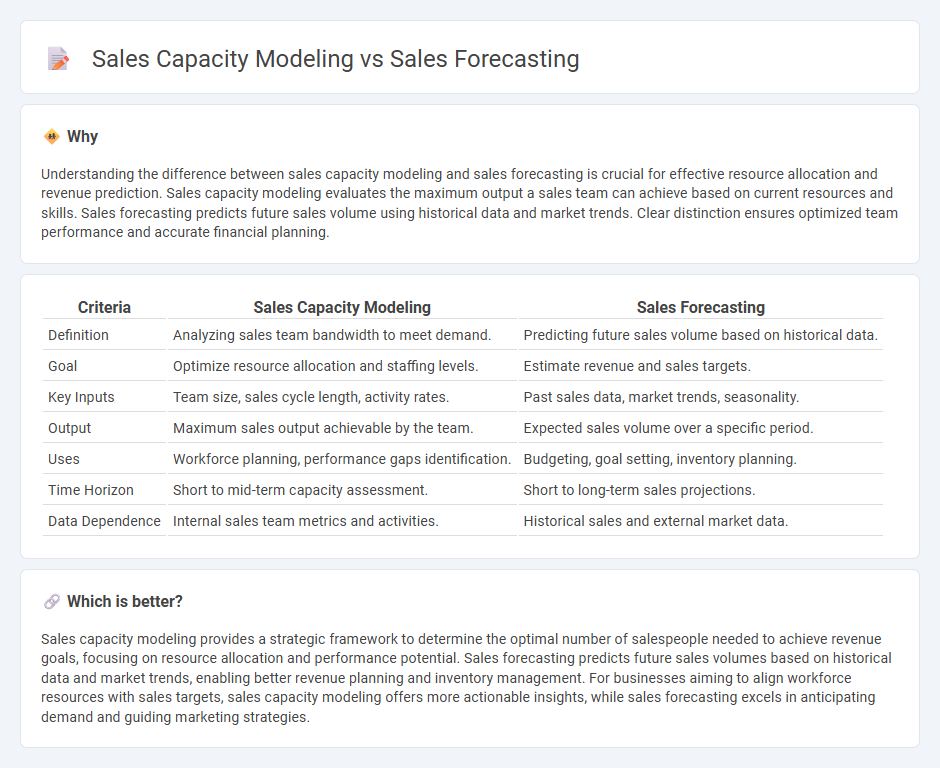
Sales capacity modeling analyzes the resources and workloads needed to achieve sales targets, focusing on team capabilities and operational efficiency. Sales forecasting predicts future revenue based on historical data, market trends, and customer behavior to guide strategic planning. Explore how integrating both approaches can optimize sales performance and drive growth.
Why it is important
Understanding the difference between sales capacity modeling and sales forecasting is crucial for effective resource allocation and revenue prediction. Sales capacity modeling evaluates the maximum output a sales team can achieve based on current resources and skills. Sales forecasting predicts future sales volume using historical data and market trends. Clear distinction ensures optimized team performance and accurate financial planning.
Comparison Table
| Criteria | Sales Capacity Modeling | Sales Forecasting |
|---|---|---|
| Definition | Analyzing sales team bandwidth to meet demand. | Predicting future sales volume based on historical data. |
| Goal | Optimize resource allocation and staffing levels. | Estimate revenue and sales targets. |
| Key Inputs | Team size, sales cycle length, activity rates. | Past sales data, market trends, seasonality. |
| Output | Maximum sales output achievable by the team. | Expected sales volume over a specific period. |
| Uses | Workforce planning, performance gaps identification. | Budgeting, goal setting, inventory planning. |
| Time Horizon | Short to mid-term capacity assessment. | Short to long-term sales projections. |
| Data Dependence | Internal sales team metrics and activities. | Historical sales and external market data. |
Which is better?
Sales capacity modeling provides a strategic framework to determine the optimal number of salespeople needed to achieve revenue goals, focusing on resource allocation and performance potential. Sales forecasting predicts future sales volumes based on historical data and market trends, enabling better revenue planning and inventory management. For businesses aiming to align workforce resources with sales targets, sales capacity modeling offers more actionable insights, while sales forecasting excels in anticipating demand and guiding marketing strategies.
Connection
Sales capacity modeling and sales forecasting are interconnected by enabling businesses to estimate the optimal size and capabilities of their sales team based on projected revenue targets and market demand. Accurate sales forecasting provides data-driven insights into future sales volumes, which inform capacity modeling to allocate resources efficiently and avoid under- or over-staffing. This alignment improves sales performance, maximizes productivity, and supports strategic decision-making for revenue growth.
Key Terms
**Sales Forecasting:**
Sales forecasting estimates future revenue based on historical sales data, market trends, and economic indicators, helping businesses set realistic targets and allocate resources efficiently. It uses quantitative models such as time series analysis, regression, and machine learning algorithms to predict sales volume and identify seasonal patterns. Explore detailed methodologies and industry-specific applications to enhance forecasting accuracy.
Pipeline Analysis
Sales forecasting estimates future revenue based on historical sales data and market trends, helping businesses predict achievable targets. Sales capacity modeling evaluates the maximum potential sales output considering team size, skill levels, and resource availability, ensuring efficient resource allocation. Explore how integrating pipeline analysis enhances accuracy in both methods for optimized sales performance.
Historical Data
Sales forecasting relies heavily on historical sales data to predict future revenue trends and customer demand patterns, using quantitative methods such as time series analysis, regression models, and machine learning algorithms. Sales capacity modeling, while also incorporating historical performance data, focuses on evaluating the internal resources and capabilities, such as workforce size and skill sets, to determine the maximum sales potential achievable. Explore more about how integrating these approaches can optimize your sales strategy and resource allocation.
Source and External Links
Sales Forecasting | Salesforce - Sales forecasting estimates expected sales revenue over a specific period by analyzing historical data, current pipeline, and market trends, often using methods like historical forecasting or pipeline forecasting to project future sales figures.
What is Sales Forecasting? - DealHub - Sales forecasting is the process of predicting future sales to optimize revenue, using tools like market analysis, historical data, and AI-powered forecasting software, with an emphasis on combining methods and adjusting forecasts as new data emerges.
Sales Forecasting 101: The Ultimate Guide - Salesloft - Sales forecasting involves predicting unit sales over time; pre-existing businesses can rely on past sales data and techniques like trend analysis and exponential smoothing to create accurate sales projections and estimate revenue.
 dowidth.com
dowidth.com